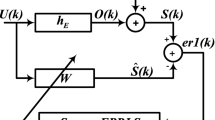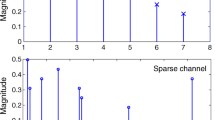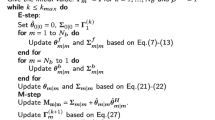Abstract
Rayleigh’s distribution is mainly used when fading wireless medium does not have proper line of sight (LOS) path and is dominated by a large number of non-line of sight (NLOS) paths due to reflections of the received signal. Also because of relative motion of the base station and mobile station, a random frequency shift is generally introduced in the carrier, which can be realized in terms of Doppler spread. In case of Rayleigh’s fading channels, there are two critical problems for receiver design that is accurate estimation of channel coefficients followed by mitigation of channel impairments like inter symbol interference and fading in presence of user mobility. The accuracy of estimated channel state information is really crucial to design robust equalizer for reconstruction of bit sequence and the equalizer performance is affected by the fading rate and Doppler spread. The main research contributions of the paper is based on the exploitation of underlying sparseness of block adaptive filters through \(l_{0}\)-norm penalty for accurate estimation with stable convergence which helps to design computationally efficient adaptive models for estimation. The accuracy of the proposed sparse block and fast block models is tested using 16 QAM modulation format with Rayleigh’s fading wireless channel for outdoor environments. With the help of MATLAB simulations, the performance of the proposed sparse BLMS and FBLMS adaptive filtering are verified and the detail comparison results are presented.








Similar content being viewed by others
References
Nakhai, M. R. (2008). Multicarrier transmission. IET Signal Processing, 2(1), 1–14.
Zhuang, W. (1999). Adaptive channel equalization for wireless personal communications. IEEE Transactions on Vehicular Technology, 48(1), 126–136.
Gunther, J., & Moon, T. (2009). Minimum bays risk adaptive linear equalizers. IEEE Transactions on Signal Processing, 57(12), 4788–4799.
Chen, R., Jr., & Wu, W.-R. (2004). Adaptive asymptotic bayesian equalization using a signal space partitioning technique. IEEE Transactions on Signal Processing, 52(5), 1376–1386.
Laot, C., Glavieux, A., & Labat, J. (2001). Turbo equalization: Adaptive equalization and channel decoding jointly optimized. IEEE Journal on Selected Areas in Communications, 19(9), 1744–1752.
Zhou, X., Liu, F., Yin, Y., Li, Q., & Qin, J. (2017). Robust beam forming for simultaneous wireless information and power transfer in MISO interference channels. Wireless Personal Communications, 92, 1545–1557.
Jiang, S. Peng, J., Lu, Z., Jiao, J., & Jiang, S., (2014). 802.11ad key performance analysis and its application in home wireless entertainment. In 2014 IEEE 17th international conference on computational science and engineering (CSE).
Naylor, P. A., Cui, J., & Brookes, M. (2006). Adaptive algorithms for sparse echo cancellation. Signal Processing, 86(6), 1182–1192.
Martin, R. K., Sethares, W. A., et al. (2002). Exploiting sparsity in adaptive filters. IEEE Transactions Signal Processing, 50, 1883–1894.
Jiang, S., & Gu, Y. (2015). Block-sparsity-induced adaptive filter for multi-clustering system identification. IEEE Transactions on Signal Processing, 63(20), 5318–5330.
Gu, Y., Jin, J., & Mei, S. (2009). Norm constraint LMS algorithm for sparse system identification. IEEE Signal Processing Letters, 16(9), 774–777.
Poggioni, M., Rugini, L., & Banelli, P. (2008). A novel simulation model for coded OFDM in doppler scenarios. IEEE Transactions on Vehicular Technology, 57(5), 2969–2980.
Ko, Y.-C., & Jeong, G. (2002). Doppler spread estimation in mobile communication systems. In IEEE Vehicular Technology Conference (pp. 1941–1945).
Banelli, P., Cannizzaro, C. R., & Rugini, L. (2007). Data-aided Kalman Tracking for channel estimation in Doppler-affected OFDM systems. In Proceedings of IEEE ICASSP (Vol. 3, pp. 133–136).
Wu, W. R., Lee, C. F., & Chen, Y. F. (2009). Time domain equalization for discrete multitone transceivers. IET Communication, 3(7), 1186–1200.
Datta, A., Hari, K. V. S., & Hanzo, L. (2014). Channel estimation relying on the minimum bit error ratio criterion for BPSK and QPSK signals. IET Communications, 8, 69–76.
Di Lorenzo, P., Barbarossa, S., Banelli, P., & Sardellitti, S. (2016). Adaptive least mean squares estimation of graph signals. IEEE Transactions on Signal and Information Processing, 2(4), 555–568.
Chang, M.-X., & Su, Y. T. (2002). Model-based channel estimation for OFDM signals in rayleigh fading. IEEE Transactions on Communications, 50(4), 1963–1968.
Li, L., He, X., & Zhang, H. (2016). Bandwidth efficient design and channel estimation over time-varying fading environments. In 9th IEEE international congress on image and signal processing, biomedical engineering and informatics (CISP-BMEI) (pp. 1091–1095).
Patraj, C., & Pal, N. R. N. (1995). A functional link artificial neural network for adaptive channel equalization. Digital Signal Processing, 43(2), 81–195.
Hussein, A., Soraghan, J., & Durrani, T. S. (1997). A new adaptive functional-link neural-network-based DFE for overcoming co-channel interference. IEEE Transactions on Communications, 45(11), 1358–1362.
Patra, J. C., Pal, R. N., Chatterji, B. N., & Panda, G. (2009). Identification of nonlinear dynamic systems using functional link artificial neural network. IEEE Transactions on Systems, Man and Cybernetics, 29(2), 254–262.
Sicuranza, G. L., & Carini, A. (2011). A generalized FLANN filter for nonlinear active noise control. IEEE Transactions on Audio, Speech and Language Processing, 19(8), 2412–2417.
Taheri, O., & Vorobyov, S. A. (2011). Sparse channel estimation with lp-norm and reweighed l1-norm penalized least mean squares. In IEEE ICASSP (pp. 2864–2867).
Angelosante, D., Bazerque, J. A., & Giannakis, G. B. (2010). Online adaptive estimation of sparse signals: Where RLS meets the l1-norm. IEEE Transactions on Signal Processing, 58, 3436–3447.
Chen, Y., Gu, Y., Hero, A. O. (2009). Sparse LMS for system identification. In Proceedings IEEE ICASSP, Taipei (pp. 3125–3128).
Martin, R. K., Sethares, W. A., et al. (2002). Exploiting sparsity in adaptive filters. IEEE Transactions on Signal Processing, 50, 1883–1894.
Etter, D. M. (1985). Identification of sparse impulse response systems using an adaptive delay filter. In ICASSP (Vol. 85, pp. 1167–1172).
Rugini, L., Banelli, P., & Berioli, M. (2007). Block equalization for single-carrier satellite communications with high mobility receivers. In Proceedings of IEEE Globecom (pp. 5021–5025).
Gross, J. H., Etter, D. M., Margo, V. A., & Carlson, N. C. (1992, August) A block selection adaptive delay filter algorithm for echo cancellation. In Proceedings of the 35th Midwest Symposium on Circuits and Systems (pp. 895–898).
Rugini, L., & Banelli, P. (2008). Frequency-domain extended models for equalization of doubly-selective channels. In Proceedings of the IEEE SPAWC (pp. 520–524).
Dentino, M., McCool, J., & Widrow, B. (1978). Adaptive filtering in the frequency domain. Proceedings of the IEEE, 66, 1658–1659.
Bershad, N. J., & Feintuch, P. L. (1979). Analysis of the frequency domain adaptive filter. Proceedings of the IEEE, 67, 1658–1659.
Narayan, S. S., & Peterson, A. M. (1981). Frequency domain LMS algorithm. Proceedings of the ZEEE, 69, 124–126.
Sahoo, H. K., & Mohanty, B. (2016). Adaptive decision feedback equalizer for SISO communication channel using combined FIR-neural network and fast block LMS algorithm. In IEEE INDICON.
Acknowledgements
Authors acknowledge the support of Veer Surendra Sai University of Technology, Burla and IIIT Bhubaneswar for providing rich resources in terms of e-journals and reference books.
Author information
Authors and Affiliations
Corresponding author
Appendix
Appendix
1.1 Base Band Channel Model for QAM
QAM modulated transmitted signal passing through the channel can be expressed as:
where \(s_{c} (k)\),\(s_{s} (k)\) and p(t) are real. p(t) is the base band signal and \(s_{c} (k) + js_{s} (k)\) represents the complex QAM symbol. The complex base band equivalent signal is
Assuming \(x_{lp} (t)\) to be transmitted over a band pass channel \(h_{bp} (t)\) with low pass equivalent \(h_{lp} (t)\):
So the channel out is:
where \(h_{lp} ,e = (h_{lp} *p)(t)\) and \(y_{lp} (t)\) denotes the complex signal
So
The QAM demodulator separates \(y_{r} (t)\) and \(y_{i} (t)\). But as \(h_{lp,e} (t)\) is complex,\(y_{r} (t)\) is a linear combination of \(s_{c} (k)\) and the interference component \(s_{s} (k)\). Similarly \(y_{i} (t)\) is the linear combination of \(s_{s} (k)\) and \(s_{c} (k)\). As \(y_{r} (t)\) and \(y_{i} (t)\) are sampled at the output of QAM demodulator,\(y_{lp} (nT)\) is the discrete version of \(y_{lp} (t)\). The equivalent complex discrete-time channel is given as \(h_{d} (n) = h_{lp,e} (nT)\) and the corresponding sampled signal is \(y_{d} (n) = y_{lp} (nT)\). Thus the expression of output signal is
where \(q(n)\) represents the channel noise.
1.2 Sparsity Introduced Through Norm Penalty
The size of a vector \(\vec{w}\) is called the norm of \(\vec{w}\), which can be represented as \(L_{1}\)-norm, \(L_{2}\)-norm, \(L_{p}\)-norm, … \(L_{\infty }\)-norm etc.
\(\vec{w} = (w_{1} ,w_{2} ,w_{3} \ldots w_{n} )\), (\(w_{i} \in C\) for \(i = 1,2, \ldots n\))
In general the \(L_{\infty }\)-norm is defined as:
Let \(w_{j}\) is the highest entry in the vector \(w_{i}\), then by the property of the infinity,
and \(\left\| {\vec{w}} \right\|_{\infty } = \sqrt[\infty ]{{\sum\nolimits_{i} {w_{i}^{\infty } } }} = \sqrt[\infty ]{{w_{j}^{\infty } }} = \left| {w_{i} } \right|\)
So the \(L_{\infty }\)-norm is defined as:
In that context the \(L_{p}\)-norm or \(l_{p}\)-norm for \(p \in N,\;1 \le p < \infty\) can be defined as:
The cost function for LMS family using \(l_{p}\)-norm penalty can be represented as:
Using gradient descent method the p-norm based update equation can be derived as:
where \(\rho_{p} = \mu \gamma_{p}\)
when the entry of \(w(k)\) approaches to zero then the above equation is modified as:
here \(\in_{p}\) indicates the bounds.
Rights and permissions
About this article
Cite this article
Sahoo, H., Mohanty, B. & Patnaik, B. Block and Fast Block Sparse Adaptive Filtering for Outdoor Wireless Channel Estimation and Equalization. Wireless Pers Commun 98, 3003–3019 (2018). https://doi.org/10.1007/s11277-017-5013-6
Published:
Issue Date:
DOI: https://doi.org/10.1007/s11277-017-5013-6




